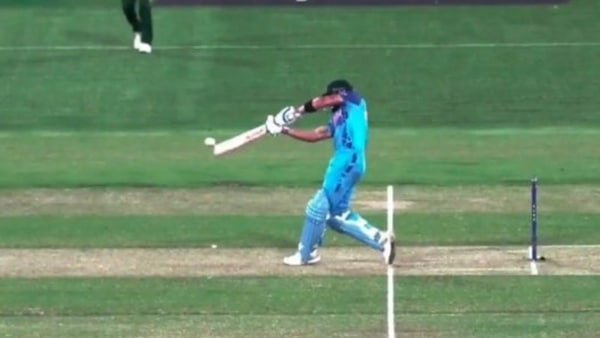IND vs PAK: Were Pakistan cheated? Was no-ball given because Virat Kohli asked? Here's what happened in last over
What precisely occurred in the last over of the India vs Pakistan clash?

Virat Kohli during IND vs PAK clash
Last Updated: 01.12 PM, Oct 24, 2022
Pakistan controlled the contest almost up till the second ball of the 19th over. Having given India a goal of 160 runs in their opening match of the ICC Men's T20 World Cup 2022, they had bowled superbly.
Virat Kohli 's outstanding batting enabled India to rescue the match against Pakistan from a certain defeat when a lot of things altered in the final over.
So, what precisely occurred in the last over?
Mohammad Nawaz of Pakistan watched Virat Kohli hit a full toss over the square leg boundary with 14 needed off of three balls. He instantly put his arm out to signal that there was no ball.
Umpire Marais Erasmus made the choice to make a height determination while standing on one leg. Standing umpire Rod Tucker called a no-ball after Erasmus said the delivery was above the waist and the six was officially called. Babar Azam and other others confronted the umpires, but it resulted in a no-ball.
Clause 41.7.1 of the Laws of Cricket, and the ICC's T20 World Cup playing conditions, confirms: "Any delivery, which passes or would have passed, without pitching, above waist height of the striker standing upright at the popping crease, is to be deemed to be unfair."
Soon after the SIX, the equation saw the Men in Blue needing six runs from three balls, with a free hit to come.
Nawaz, under pressure, delivered a wide. He then later delivered an inch-perfect yorker that beat Kohli's bat which was attempting a slog sweep.
The ball struck his stumps, but because it was a free hit, it did not result in an OUT, and Kohli and Dinesh Karthik ran three runs which were declared as byes.
The umpire and Babar Azam then debated whether or not the Indian team should be given the runs. Since it struck the stumps, the Pakistani captain wanted the delivery to be referred to as a "dead ball."
The MCC Laws of Cricket, however, provide that the ball can only be declared dead when "a boundary is scored" or "it is finally settled in the hands of the wicketkeeper or of the bowler."
The ball is also referred to as a "dead ball" if "A batter gets thrown out. The moment the incident that led to the discharge occurred, the ball was declared to be dead."
Law 20.1.1 also provides that the umpire's decision-making power may also be used in other situations to declare a ball dead.
When "one or both bails fall from the striker's wicket before the striker has had the opportunity to play the ball," the umpire may declare the ball dead if it strikes the stumps.
There are only four ways to be dismissed in free-hit: handled the ball, hit the ball twice, obstructed the field, and run out. Given that the ball was still in play, India received a bye.
Soon after, Rizwan stumped Karthik who was attempting to take a sweep shot. R Ashwin came to the crease with Kohli still at the non-striker's end.
Ashwin was in a relaxed frame of mind when Nawaz bowled his ball, and he knew it was going for a wide and so he left the ball.
With one ball remaining and one run needed, Ravichandran Ashwin maintained composure to lead India to victory.
